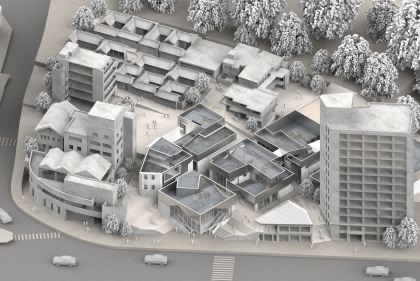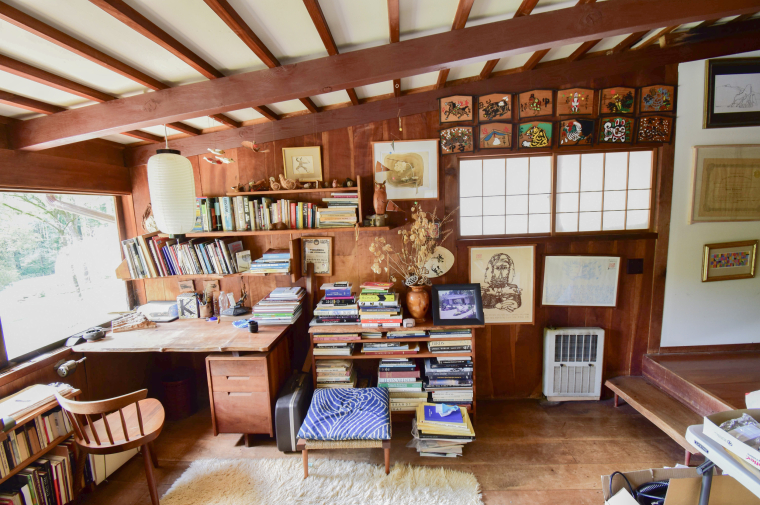August 1, 2025
Stuart Weitzman School of Design
102 Meyerson Hall
210 South 34th Street
Philadelphia, PA 19104
Get the latest Weitzman news in your Inbox
Areas
An ancient city preserved in amber, Herculaneum is a one-of-a-kind archaeological site that was transformed, for 5 weeks this summer, into a crash course in sustainable preservation planning for young heritage professionals, including five Weitzman students.
The program was organized in a partnership between the Weitzman School of Design Department of Historic Preservation and ICCROM, supported by Dawn and Brian Gonick as well as the Packard Humanities Institute, and with contributions from Parco Acheologico di Ercolano and the Fondazione Ente Ville Vesuviane.
Mount Vesuvius overlooks the ancient city Herculaneum (foreground), as well as the modern city of Ercolano on the hills above.
Herculaneum is an ancient city south of Naples that, like neighboring Pompei, was buried under a Vesuvian explosion in 79 AD. Today, after several centuries of excavation and interventions, the fragile archaeological fabric faces unique conservation challenges, which became a rich laboratory for budding professionals to learn from experts in the field.
Guided by archaeologists, conservators, and architects, students examined the site at numerous scales and across many disciplines. Particular emphasis was placed on sustainable, forward-thinking management in the face of disaster and climate change from an international perspective.
Below, the Weitzman students who were in attendance reflect on the complexity of the project work and emphasize the importance of building coalitions with the public when doing heritage work.
Ke-An Chiang (MSHP’25)
Conserving exposed materials is challenging, and preserving archaeological sites involves many layers—including potential impacts on the community, which was truly eye-opening—but what stayed with me most is the role we play in navigating those complexities to communicate the site’s integrity and help others understand its narrative.

The Weitzman delegation in Ercolano. From left: Sallishah Ali, Ke-An Chiang, Shailee Bhagat, Anna Veilleux, and Caroline Griffis.
Anna Veilleux (MSHP’25)
The Herculaneum program offered a unique and valuable opportunity to examine conservation’s impact at both micro and macro scales. We studied deterioration patterns, such as those caused by earthquakes or precipitation, on individual Roman materials, while also considering broader effects of significant precipitation and seismic activity on the modern community. This perspective informed treatment plans that supported both the conservation of materials and the resilience of the surrounding area.
This holistic idea of conservation is a valuable lesson that I will carry into many of my future projects. In other words, we need to make sure that our “micro” scale approaches (e.g., chemical analysis) does not exclude our understanding of how our sites, actions, and resources impact the surrounding communities. So, for example, if we were to implement earthquake training and repair strategies for our workers and sites, we should also ensure that the surrounding community is also trained and protected. Excluding the community only breeds a site that isn’t cared for. The resilience of a site is built through making sure that it is cared for by the local community as well!
Sallishah Ali (MSHP’25)
A key experience for me during the HSS was working on a project where the different scales of preservation strategies inform one another. Additionally, working on an archaeological site within an urban setting presented new challenges I was unfamiliar with. So, while touring the site with the archaeologists, architects, and conservators (from [the Packard Humanities Institute]) I gained a new perspective on how preservation planning works for these types of sites.
Following the preservation and capstone studios [at Weitzman], I felt well equipped to conduct meetings with stakeholders. For the HSS, even though we’d been in conversation with a variety of working professionals, when we sat down to interview some of them with our “consultant hats,” their responses informed our work as they shared the aspirations of the site that was reflective of the needs of the community we also interviewed as well as providing insight on the macro-plan, their aspirations etc. that impacted our considerations.
Shailee Bhagat (MSHP’25)
The most valuable outcome of participating in the summer school was the opportunity to collaborate with individuals from diverse disciplines and school of thought, all united by a shared ethos for the site. It was enlightening to see how each of us brought a different approach to its preservation.
Caroline Griffis (MSHP’26)
It was the privilege of a lifetime to spend three weeks amongst the faded frescoes and carbonized wood at Herculaneum. Our cohort analyzed hazards and vulnerabilities to the archaeological site's built structures, and also brainstormed innovative strategies for increasing environmental preparedness and accessibility. Intensive site work was complemented by world-class lectures from renowned heritage sector professionals, and we had many opportunities to immerse ourselves in Neapolitan culture and Italian conservation practices. I appreciated seeing the tangible results from the successes and failures of conservation treatments during different time periods, and I learned a lot about sustainable site management strategies and risk analysis. Overall, it was an incredible and professionally empowering experience which has exposed me to both cutting-edge modern tech and ancient city planning and artistry.


 Expand Image
Expand Image


